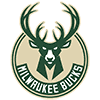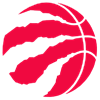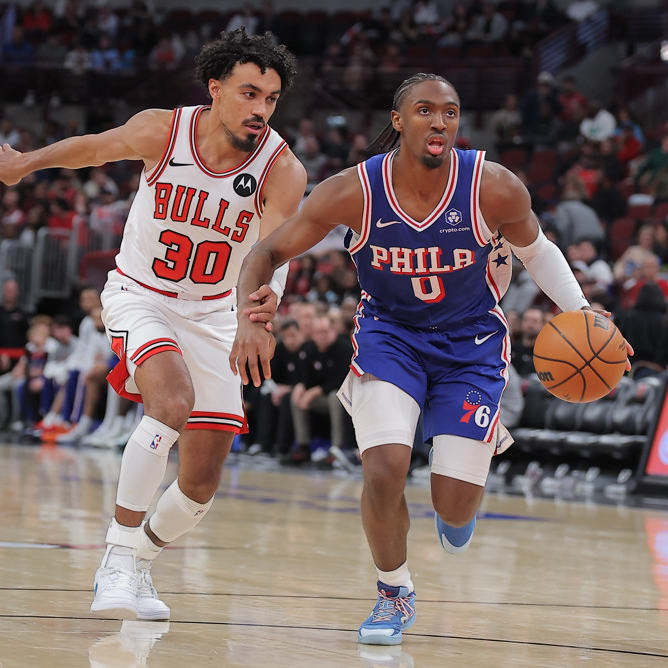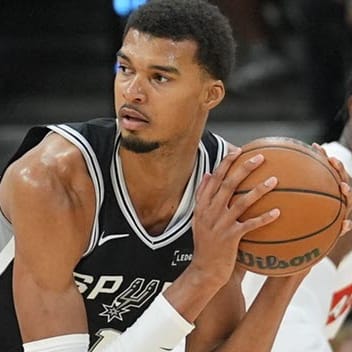Unlike fantasy football, played almost exclusively in points formats, fantasy basketball has a few scoring variations. In addition to points leagues, there are category leagues, where the goal is to win more statistical categories than your opponent.
The two scoring settings create variance in rankings. Some players are more valuable in one league format than the other. To be competitive, it's essential to understand the differences.
What are category leagues?
Your typical category league has nine categories, and you battle the other managers among those nine statistics. Those categories include points, rebounds, assists, steals, blocks, free-throw percentage, field goal percentage, three-pointers made and turnovers. The main two types of category leagues include head-to-head and rotisserie. In a head-to-head league, you face one manager every week and battle in those nine categories, winning 9-0 in a perfect week. A rotisserie league is where you play the whole season and battle every manager in the league standings in those categories. If you're in a 10-team league, the perfect team would finish with 90, scoring a 10 in all nine categories.
What are points leagues?
Almost every fantasy football league is played in a points format, and it's become more prevalent in fantasy basketball over recent years. This is where every statistic is worth a specific value, and you add up all of these fantasy points for every individual player. For example, this is what a points league looks like for Yahoo:
Points: 1
Rebounds: 1.2
Assists: 1.5
Steals: 3
Blocks: 3
Turnovers:
Unlike fantasy football, played almost exclusively in points formats, fantasy basketball has a few scoring variations. In addition to points leagues, there are category leagues, where the goal is to win more statistical categories than your opponent.
The two scoring settings create variance in rankings. Some players are more valuable in one league format than the other. To be competitive, it's essential to understand the differences.
What are category leagues?
Your typical category league has nine categories, and you battle the other managers among those nine statistics. Those categories include points, rebounds, assists, steals, blocks, free-throw percentage, field goal percentage, three-pointers made and turnovers. The main two types of category leagues include head-to-head and rotisserie. In a head-to-head league, you face one manager every week and battle in those nine categories, winning 9-0 in a perfect week. A rotisserie league is where you play the whole season and battle every manager in the league standings in those categories. If you're in a 10-team league, the perfect team would finish with 90, scoring a 10 in all nine categories.
What are points leagues?
Almost every fantasy football league is played in a points format, and it's become more prevalent in fantasy basketball over recent years. This is where every statistic is worth a specific value, and you add up all of these fantasy points for every individual player. For example, this is what a points league looks like for Yahoo:
Points: 1
Rebounds: 1.2
Assists: 1.5
Steals: 3
Blocks: 3
Turnovers: -1
As you can see, each stat is counted differently because these statistics are not all valued equally. Points and rebounds are the most prevalent stats in basketball, while steals and blocks are the rarest. The key to scoring value in a points league is ensuring that every position is valued equally because drafts could be altered if one category is valued too much relative to others.
What are the major differences?
The most significant difference between category and points leagues is the impact of shooting efficiency and three-pointers. In category formats, a player's field-goal and free-throw percentages affect their fantasy value positively or negatively. Big men, for example, often have poor free-throw percentages. If they get to the charity stripe at a high volume, it can be a significant detriment to your team. Also, three-point specialists are more valuable in category formats since the category is weighted individually. In points formats, it's simply lumped in with points. Specialists of all types are typically more valuable in category leagues, while usage rate is more correlated with fantasy value in points leagues.
Players who are better in points leagues
Russell Westbrook, Clippers
This is the ultimate categories versus points player! Many category managers refuse to draft Westbrook because he crushes you in field goal percentage, free-throw percentage and turnovers. He's been one of the worst in the league in all those, but he's been an elite stat-stuffer throughout his career. The guard is averaging 17.2 points, 7.3 assists, 6.6 rebounds and 1.0 steals over the past two seasons. That's great in a points league, but his 66.2 percent free-throw shooting and 3.6 turnovers over the last five years kill him in category formats.
Paolo Banchero, Magic
The 2023 Rookie of the Year easily led his team in usage last season, averaging 20.0 points, 6.9 rebounds and 3.7 assists in 33.8 minutes -- numbers that should only rise as a sophomore. However, his subpar percentages (42.7 FG%; 73.8 FT%) and lack of defensive stats (0.8 STL, 0.5 BLK) ranked him outside the Top 100 in category formats. But as someone with upside for 40 fantasy points per game this year (35.2 FP/g last season), Banchero could be taken as high as the third round in points formats without much risk.
Giannis Antetokounmpo, Bucks
The Greek Freak's free-throw percentage last season (64.5 FT%) was the most damaging in fantasy basketball, considering he took 12.3 per game. Plus, he averaged 3.9 turnovers, and his defensive stats were down (0.8 STL, 0.8 BLK). While his nine-category per-game rank of 91 was an unfair assessment of his fantasy value in that format, it shows how drastically his free-throw percentage affects things. Meanwhile, he averaged 54.8 fantasy points per game, making him worthy of a No. 1 overall selection in points formats. The same dichotomy will exist again this season.
Players better in category leagues
Myles Turner, Pacers
Turner has one of the most unique skill sets in the NBA. The big man regularly leads the league in blocks and is an adept three-point shooter. He's coming off a career year with averages of 18.0 points, 7.5 rebounds, 2.3 blocks, 1.5 threes and 1.4 assists. His assists are his only significant negative in a categories league, as Turner's percentages (54.8 FG%; 78.3 FT%) were also impressive.
Brook Lopez, Bucks
Lopez and Turner are valuable for all the same reasons. He's not quite as good of a rebounder as he should be, but Bro-Lo averaged 15.9 points, 6.7 rebounds, 1.3 assists, 0.5 steals, 2.5 blocks and 1.7 threes on 53 percent from the field and 78 percent from the free-throw line last year. Those 4.2 combined blocks and threes are incredibly unique, especially from a guy averaging 16 points and seven boards on great percentages.
Draymond Green, Warriors
Green's low scoring causes many points league managers to look elsewhere, but his 8.5 points per game last season shouldn't bother category managers as much. It came with 7.2 rebounds, 6.8 assists, 1.0 steals and 0.8 blocks -- numbers that give him utility in almost all category league builds. He also shot 52.7 FG% last year, and his subpar 71.3 FT% was on volume of just 1.5 attempts per game.






































